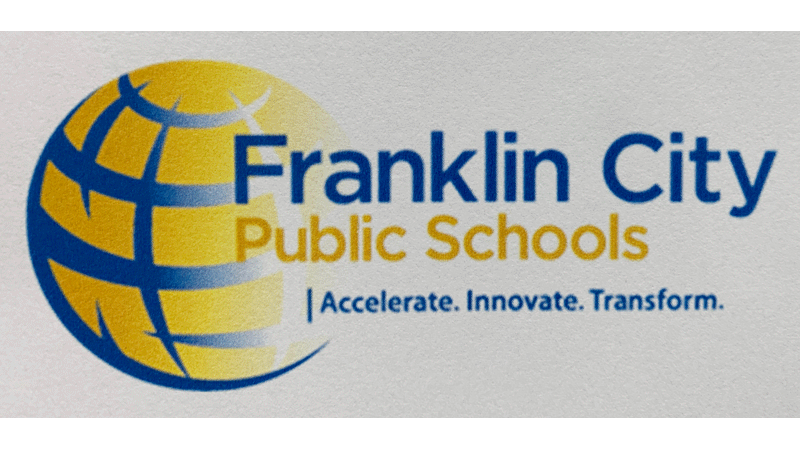Data review: Growth evident at S.P. Morton
Published 9:10 am Friday, March 22, 2024

- (Courtesy of Franklin City Public Schools)
|
Getting your Trinity Audio player ready...
|
Editor’s note: Franklin City Public Schools administrators presented a Quarter 2/Semester 1 student performance data review for the 2023-24 school year to the Franklin City School Board on Thursday, Feb. 29. This is the third in a three-part series covering the review, school-by-school.
A Feb. 29 data review of student performance at S.P. Morton Elementary School revealed gains in many areas, with some notable work remaining in reading.
During a March 5 interview, Franklin City School Board Chair Robert Holt offered a broad explanation of student performance trends at SPM, along with his and the board’s overall impression of student progress from Quarter 1 to Quarter 2 at the elementary school.
“Typically and historically, the kids that come to S.P. Morton in kindergarten are very far behind,” he said. “They’re not ready for school, so in kindergarten grades one and two, we spend a lot of extra time with reading because that’s such a critical subject, and we can get more bang for the bucks the better at reading kids are.
“So by the time they get to the third grade, that’s the first SOL testing grade, and sometimes those scores are not what we want them to be, so we put a lot of emphasis there,” he continued. “That really tells us competitively where our kids stack up statewide, beginning in the third grade.
“By the time they finish S.P. Morton in the fifth grade, they’re caught up,” he said. “They’re pretty much at state average or sometimes better.”
As for a reaction to the Feb. 29 data review, he said, “I think we were happy with S.P. Morton. We can see that the kids in the red, that area was declining. The kids in the green, that area was going up, and of course, the yellow, the kids were in the middle. Yellow means that they’re not quite at green yet, but they are getting very close. So then we know where to put some emphasis, and obviously you’re going to do it with the yellow and the red and try to maintain the green.
“I think S.P. Morton is doing pretty well right now,” he added.
SPM Principal Angela Fair presented the data during the Feb. 29 meeting.
The presentation began with kindergarten performance data derived from an assessment known as PALS.
Kindergarten PALS Data
Red: Quarter 1 – 27%; Quarter 2 – 17%
Yellow: Q1 – 50%; Q2 – 43%
Green: Q1 – 23%; Q2 – 40%
Grade 1 PALS Data
Red: Q1 – 77%; Q2 – 43%
Yellow: Q1 – 20%; Q2 – 43%
Green Q1 – 3%; Q2 – 14%
Grade 2 PALS Data
Red: Q1 – 78%; Q2 – 64%
Yellow: Q1 – 22%; Q2 – 30%
Green: Q1 – 0%; Q2 – 6%
Grade 3 PALS Data
Red: Q1 – 62%; Q2 – 55%
Yellow: Q1 – 38%; Q2 – 27%
Green: Q1 – 0%; Q2 – 18%
Grade 3 Reading Benchmark Comparison
Red: Q1 – 63.93%; Q2 – 77.27%
Yellow: Q1 – 11.48%; Q2 – 9.09%
Green: Q1 – 24.59%; Q2 – 13.64%
Average Score: Q1 – 50%; Q2 – 43%
The percentages listed for “Average Score” represent how all students at the relevant grade level and in the relevant school subject scored on the SOL, assuming a 0% to 59% would be red and failing, 60% to 70% would be yellow and passing, and 71% to 100% would be green and passing comfortably.
Grade 3 Reading Student Growth Assessment Data
Red — Needs Support: 45; Decreased: 24
Yellow — At Risk: 20; Stayed the Same: 16
Green — Prepared: 3; Grew 1 Band+: 18
These numbers indicate that there were 45 students who failed the SOL in the fall but only 24 who failed in the winter. For yellow, 20 passed the SOL in the fall, and 16 passed in the winter.
Franklin City Public Schools Director of Curriculum and Instruction Krystal Thompkins said, “When you say, ‘prepared,’ that means those kids are on track to also pass the SOL.”
“Band” refers to the color bands identified, namely red, which includes students who are failing the SOL and need additional support; yellow, which includes students who are passing the SOL but at risk of failing; and green, which includes students who are passing the SOL comfortably and are prepared.
Grade 4 Reading Benchmark Comparison
Red: Q1 – 43.75%; Q2 – 65.22%
Yellow: Q1 – 23.44%; Q2 – 11.59%
Green: Q1 – 32.81%; Q2 – 23.19%
Average Score: Q1 – 59%; Q2 – 50%
Grade 4 Reading Student Growth Assessment Data
Red — Needs Support: 35; Decreased: 20
Yellow — At Risk: 23; Stayed the Same: 13
Green — Prepared: 9; Grew 1 Band+: 30
In the above data for Grade 4 Reading, the benchmark comparison depicts some negative trends, while the SGA data shows some positive growth. FCPS Director of Assessments and Accountability Meta Stratton explained why this is possible.
“One thing that is worth mentioning is that the SGA and Benchmark are not measuring the same thing,” she said. “They should not be compared apples to apples. Benchmarks measure the strands that are on the assessment only. SGAs measure growth over time and can actually have strands from multiple years of instruction.”
Grade 5 Reading Benchmark Comparison
Red: Q1 – 61.67%; Q2 – 69.84%
Yellow: Q1 – 20%; Q2 – 14.29%
Green: Q1 – 18.33%; Q2 – 15.87%
Average Score: Q1 – 48%; Q2 – 47%
Grade 5 Reading Student Growth Assessment Data
Red — Needs Support: 41; Decreased: 29
Yellow — At Risk: 17; Stayed the Same: 11
Green — Prepared: 4; Grew 1 Band+: 19
Grade 3 Math Student Growth Assessment Data
Red: Q1 – 70.49%; Q2 – 51.56%
Yellow: Q1 – 14.75%; Q2 – 15.63%
Green: Q1 – 14.75%; Q2 – 32.81%
Average Score: Q1 – 45%; Q2 – 54%
Grade 3 Math Student Growth Assessment Data
Red — Needs Support: 56; Decreased: 14
Yellow — At Risk: 11; Stayed the Same: 20
Green — Prepared: 1; Grew 1 Band+: 23
Grade 4 Math Benchmark Comparison
Red: Q1 – 43.75%; Q2 – 65.22%
Yellow: Q1 – 23.44%; Q2 – 11.59%
Green: Q1 – 32.81%; Q2 – 23.19%
Average Score: Q1 – 35%; Q2 – 46%
Ward 2 Board Member Arwen Councill said, “What happened there? The red increased.”
Addressing Fair, Councill said, “We’re hearing really great things about how you’re creating positive leadership in the school. So I understand it takes time for change, but I’m just curious, even with all the growth, which (I’m) super excited to see any progress anywhere, red is still the dominant color on most of the graphics.”
Fair explained that this data shows administrators how to strategically plan.
“So for instance, we developed tutoring programs after school for math and for reading to reach those students who need that extra support, so we actually have tutoring Monday, Tuesday, Wednesday and Thursday,” she said. “We have a Monday and Wednesday group, (and) we have a Tuesday/Thursday group.
“And then we’re building in extra sessions for the kids to get support even during the day, so that’s what this data’s telling us,” she added. “We see who’s moving and who’s growing, but now we need to do some more things to help those who may be growing but they’re still at red.”
Councill said, “So I guess we’ll see within the next quarter if we’re able to determine that the tutoring is making a difference and all that.”
She added, “I’m also on the calendar committee, so I’m thinking — length of the day and adding tutoring and these poor babies, it’s like they never get to go home. Everything has a connection to everything else.”
Ward 3 Board Member LaChanda E. Parker highlighted the growth seen in many scores thus far, and said, “I’m only expecting it to keep growing.”
Grade 4 Math Student Growth Assessment Data
Red — Needs Support: 52; Decreased: 26
Yellow — At Risk: 14; Stayed the Same: 19
Green — Prepared: 2; Grew 1 Band+: 26
Grade 5 Math Benchmark Comparison
Red: Q1 – 83.33%; Q2 – 77.05%
Yellow: Q1 – 5%; Q2 – 4.92%
Green: Q1 – 5%; Q2 – 18.03%
Average Score: Q1 – 35%; Q2 – 46%
Grade 5 Math Student Growth Assessment Data
Red — Needs Support: 57; Decreased: 21
Yellow — At Risk: 4; Stayed the Same: 29
Green — Prepared: 2; Grew 1 Band+: 10
Grade 4 Virginia Studies Benchmark Comparison
Red: Q1 – 90.63%; Q2 – 53.13%
Yellow: Q1 – 4.69%; Q2 – 18.75%
Green: Q1 – 4.69%; Q2 – 28.13%
Average Score: Q1 – 36%; Q2 – 55%
Parker said, “Did they figure out a way to make Virginia Studies fun?”
Ward 4 Board Member and Board Vice Chair Cristina Boone said, “Ms. (La’Quiesha) Seaborne, she’s an excellent teacher.”
Fair indicated that Seaborne did a phenomenal job.
“The kids want to go, they want to go to the class,” Fair said.
Grade 5 Science Benchmark Comparison
Red: Q1 – 76.67%; Q2 – 53.45%
Yellow: Q1 – 10%; Q2 – 25.86%
Green: Q1 – 13.33%; Q2 – 20.69%
Average Score: Q1 – 46%; Q2 – 46%




